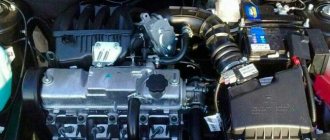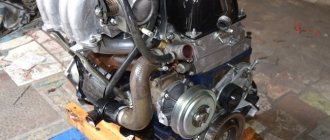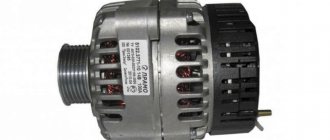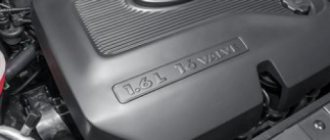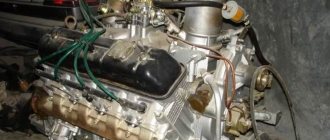On a VAZ 2101 car, the engine has a displacement of 1.2 liters. This is the minimum engine size; it was installed on almost all VAZ cars. Some argue that engines from Fiat were installed on kopecks. But we must not forget that the 2101 engine was actually made on the basis of an Italian-made car engine. But the distance between the centers of the cylinders is much greater than that of the Fiat. Due to this, VAZ engineers could make an engine with different volumes on the same basis. Actually, it gave rise to engines with a displacement of 1.5, 1.6, 1.3, as well as for Niva cars.
Specifications
Characteristics of the VAZ 2101 engine Years of production – (1970 – 1983) Cylinder block material – cast iron Power system – carburetor Type – in-line Number of cylinders – 4 Valves per cylinder – 2 Piston stroke – 66 mm Cylinder diameter – 76 mm Compression ratio – 8.5 Volume VAZ 2101 engine – 1198 cm3 Engine power VAZ 2101 – 59 hp. /5600 rpm Torque – 89 Nm Fuel – AI92 Fuel consumption – city 9.4 l. | track 6.9l. | mixed 9.2 l/100 km Oil consumption - 700 g. per 1000 km Weight of the VAZ 2101 engine - 114 kg Overall dimensions of the VAZ 2101 engine (LxWxH), mm - 540x522x621
What kind of oil to pour into the VAZ 2101 engine:
5W-30 5W-40 10W-40 15W-40
How much oil is in engine 2101: 3.75 l. When replacing, fill in about 3.5 liters.
VAZ 2101 engine life : 1. According to the plant – 125 thousand km 2. In practice – 200 thousand km
TUNING Potential – 200 hp. Without loss of resource, about 70-75 hp.
Engine 2101 was installed on : VAZ 2101 VAZ 2102 VAZ 21035 VAZ 21041 VAZ 21051
Advantages and disadvantages
In the first years of operation, the 2101 engine revealed the following shortcomings:
- noisy operation of the chain drive;
- increased gasoline consumption in the engine due to defects in carburetors;
- frequent ignition adjustments;
- Difficult adjustment of valve clearances.
Solex carburetor
However, a cylinder head improved with a camshaft, an improved intake manifold and an exhaust manifold of the simplest design compensated for these shortcomings. A little later, DAAZ Ozone carburetors were developed, replacing which made it possible to improve the characteristics of internal combustion engine modes.
Carburetor Ozone
Positive aspects of the engine
The “penny” has a 4-cylinder in-line engine, the camshaft is located in the upper part. The gas distribution mechanism on the “penny” is driven using a chain. If you don’t tear the engine too much, its service life is about 200 thousand km. It is worth noting that several decades ago, tests were carried out on engines that were installed on cars traveling throughout the Soviet Union. The tests involved cars that drove through deserts, steppes, and in permafrost conditions. Moreover, the motors have traveled more than 200 thousand kilometers. And they have never undergone major repairs. As inspections have shown, they could still serve for a very long time without repair. Their resource turned out to be quite high. At the same time, only the oil recommended by the manufacturer was poured into the VAZ 2101 engine.
Creation of VAZ-2101
Everyone knows that the VAZ 2101, or in common parlance “Kopeyka”, copied the external features and technical features from the Italian Fiat-124 model of 1966.
Of course, all materials for production were used only Soviet ones. The first stage of the plant was put into operation on March 24, 1971 and was designed to produce 220,000 cars per year. The following year, AvtoVAZ doubled its production capacity.
The VAZ-2101 was created as a low-power car (four-cylinder engine capacity was 1.2 liters; power - 62 hp at 600 rpm; maximum speed - 140 km/h) and with a relatively low price, so that everyone could afford to buy a legendary car.
Compared to the Italian prototype, the VAZ-2101 acquired rear drum brakes (instead of disc brakes), which were more durable and resistant to dirt. According to the characteristics of our roads, the ground clearance was also increased, the body and suspension were strengthened. In all subsequent years, the VAZ model was refined and subjected to modifications. But even in this (pristine) form, the VAZ-2101 was produced until 1982 and became a truly “people's” car.
Engine maintenance, valve adjustment intervals.
True, the engine requires timely maintenance. In particular, it is picky about the valve clearance. Approximately once every ten thousand kilometers, adjustments need to be made. If this is not done, a knock will appear, and after warming up the engine may simply stall. As for the injection system of the penny engine, it also needs adjustments and repairs. It is worth noting that the motor has many shortcomings if you look at it from the point of view of modern technology. About 700 grams of oil is consumed per thousand kilometers; if you have a high mileage engine, then even more. It is also quite common for the engine to overheat. And the reason for this may lie in both the thermostat and the liquid pump. Much less often it is caused by a fan failure. On some you can still find a cooling system that uses a mechanically driven impeller. Sometimes high engine temperatures appear after refueling with gasoline with a very high octane number. On a VAZ 2101 car, engine power can be increased if some modernization is carried out. This will be discussed below.
An interesting article about biofuel produced from ordinary sawdust, read more here.
Flaws
The power unit was developed on the basis of a prototype FIAT 124 engine, so it was not without its characteristic shortcomings that worried car owners:
- For example, the use of first-generation carburetors led to an increase in fuel consumption. Even in mixed mode, this 1.2 liter engine consumed about 10 liters per 100 kilometers.
- Quite often there were problems with the ignition, which constantly required adjustment.
- Also, during operation, the valve clearances were lost, which led to problems in the operation of the power unit. As a result, it was necessary to carry out complex and time-consuming repairs that involved opening the valve cover.
If there is smoke coming from the exhaust
If the engine begins to smoke, then most likely the seals on the valves have been destroyed. Or the guide bushings are completely worn out. Minor faults include, for example, incorrect carburetor settings; it creates a mixture that is too rich. And the saddest failure is the destruction of the piston rings. On the VAZ 2101, the engine was initially equipped with a classic contact ignition system. It is very picky and requires constant care, cleaning contacts, and adjusting gaps. Therefore, many motorists prefer to install a contactless ignition system. But what kind of engine can be installed on the VAZ 2101? There is only one answer to this - anyone! It all depends on how “golden” your hands are.
If the engine troits - reasons
Causes of “triple tripping” of a VAZ car engine
- Incorrect ignition timing
- Spark plug fault
- High voltage wire breakdown. Capacitor failure
- Loss of tightness in the intake manifold area (intake manifold, carburetor)
- Burnout of valve, piston
- Broken piston rings
- Incorrect valve adjustment
- Destruction and wear of rockers (valve levers)
- Cylinder head gasket failure
- Wear, hardening, destruction of valve stem seals
- Very low fuel quality
- Incorrect carburetor adjustment
- Wear of distributor shaft, rotary plate bearing
- Loss of tightness of the membrane of the vacuum ignition advancer
- Use of spark plugs that are not suitable for the engine and other “malfunctions”
- Incorrect ignition timing. With this option, I personally know not a tripping, but a seemingly slamming of the engine (missing), which is accompanied by “bouncing” of the entire engine. This is especially noticeable at idle; as the speed increases, the skips disappear. Most likely, your ignition is set too early; this may also be indicated by jerky cranking of the engine by the starter when starting.
- A faulty spark plug is one of the most common causes of engine misfiring. There is nothing special to tell here, it is important to remember and replace spark plugs regularly, and the presence of a spark on an inverted spark plug at atmospheric pressure does not indicate its full functionality, because ignition occurs under much more difficult conditions (Za Rulem magazine, dating back to Soviet times).
- Breakdown of the high-voltage wire and capacitor on the contact ignition system. A wire breakdown can be determined by replacing all the wires, as well as the capacitor. You can also try to determine the breakdown of the wire by looking at them in complete darkness; if there is a breakdown somewhere, you will see flashes.
- Loss of tightness in the collector area, as a rule, does not occur on its own. More often this happens due to incorrect assembly or bad gaskets.
- As a rule, when a piston or valve burns out, the cylinder stops working altogether or does not work for a long time. It can only be determined by measuring compression and opening the engine.
- Breakage or sticking of piston rings is also not a very common occurrence, because a number of conditions are necessary for its occurrence. You can check it by measuring the compression; if it turns out to be low, then eliminate cylinder head malfunctions in a simple way - pour a little oil into the cylinder; if the compression increases, then there is a malfunction in the piston system.
- With incorrect valve adjustment, everything is already clear - any valve may not open or close completely. Proper valve adjustment can cure this problem. Rocker wear can cause a similar problem. The valve stops opening correctly and the cylinder stops working.
- Trambler. Quite often, on not new machines, wear of both the shaft itself and the bushings in which it rotates occurs, as a result of which it becomes impossible to establish an adequate gap between the contacts. The same thing happens if the swing plate bearing is worn out. Also, misfires can occur due to depressurization in the vacuum ignition timing advancer, where the membrane may fail.
Final word
Strictly speaking, the whole idea of boring the cylinders will cost a lot of money, while reducing the service life of the engine, which is not new anyway. And is it worth demanding anything from a 50-year-old engine? A much simpler way of “tuning” a penny would be to install the entire engine in it, removed, for example, from a five.
Less fuss, more accurate results. And certainly such an engine will not heat up, leak, knock and bring other surprises that the products of the Volzhsky Automobile Plant so love to give to their owners.
Installing a turbine will help radically increase power, but wait, are you serious? Turbine for a penny? For what? Perhaps for night drives in the company of like-minded car maniacs. Moreover, such a modification for a classic is a direct route to the landfill. Not even 20 thousand miles will pass before it will be finished, and such an engine will no longer be subject to restoration. So it’s hard to call this tuning - rather murder.
To summarize, we can say that it is easier to rearrange the engine of a VAZ 2101 than to engage in expensive overclocking for the sake of a dubious result.
Engine modernization
Fortunately, you can improve the engine if you upgrade it. Of course, you will have to get rid of all the shortcomings described above. You will also need to acquire the necessary tools and materials, which entails certain financial expenses. It would be much easier to install an engine from a nine or twelfth, they are more high-speed and powerful. And most importantly, they fit perfectly in terms of fastenings. Of course, you can bore the cylinders to a diameter of 82 millimeters in order to subsequently install pistons from the Niva car. But make sure that the bottom of the pistons is flat. It is best to take these elements from a VAZ 2112 car. Provided that the total stroke is 66 millimeters, the engine volume will increase to 1.4 liters. Consequently, the power characteristics of the VAZ 2101 engine will improve significantly.
Malfunctions
| FAULTS | CAUSES AND REPAIRS |
| The appearance of a loud knock under load, which was heard even with the hood closed. | The problem is caused by misaligned valve clearance. The repair in this case consists of opening the valve cover of the VAZ 2101 engine and adjusting the gap. |
| High oil consumption. | This indicates wear on the pistons. Leaks may also appear from under the valve cover. In the first case, a serious overhaul is required. |
| Systematic overheating of the motor. | The thermostat or fan has failed. If the fan is working, the thermostat or water pump must be replaced. |
| Blue smoke comes from the chimney. | The reason for this is the failure of valve seals, guides and bushings. Repair consists of replacing damaged elements. |
Tuning
But pay attention to the year of manufacture of the engine of your “penny”. If it’s earlier than ’74, then this option with Niva pistons can work. If later, you can install pistons with a maximum diameter of 79 millimeters. In this case, it is advisable to install the crankshaft from the newer model 2103, and it is advisable to take the connecting rods from the same one. But keep in mind that you should not install short connecting rods. They increase the force with which the pistons are pressed against the cylinder. Consequently, the reliability of the motor, as well as its service life, deteriorates many times. And when you repair a VAZ 2101 engine yourself, take into account all the nuances and try to comply with the requirements.
Increasing the engine capacity of the VAZ 2101
The most popular word that comes to mind when thinking about increasing the engine capacity of a VAZ 2101 - 21063 is boring.
But you should understand that by boring to the maximum repair size in the case of the VAZ 2101-21063 and other classic engines with a volume of 1.2, 1.3 liters, you will only get one hundred cubic centimeters of volume. The cylinder diameter of the VAZ 2101 engine is 76mm, you sharpen it to 79mm - this gives the above-mentioned hundred cubes, but the walls between the cylinder itself and the cooling channels become much thinner, the engine is more prone to overheating. Maybe if you don’t drive a lot, high-quality work on such a boring makes sense, but if you drive 50,000 km a year, or maybe more, you should understand that such a motor will not have another boring, there is simply nowhere to sharpen it. What if a damaged piston scratches the cylinder wall? - with such a “maximum” boring, you will have to change the engine block. If you do the boring procedure on a 1.3 engine with 79mm walls, you can bore it to a maximum of 82mm, with a piston stroke of 66mm (piston stroke on classic engines 2101-21063 1.2, 1.3l) you will also get an additional hundred cubes. It is worth understanding that such a method of increasing volume will not give a significant increase in torque or power; increasing the volume in this way makes sense when all previous repair dimensions have already been completed.
Maintenance
Considering the design of the internal combustion engine, the manufacturer recommends the following maintenance schedules:
| Maintenance object | Time or mileage (whichever comes first) |
| Valve train chain | replacement after 100,000 km |
| Battery | 1 year/20000 |
| Valve clearance | 2 years/20000 |
| Crankcase ventilation | 2 years/20000 |
| Belts that drive attachments | 2 years/20000 |
| Fuel line and tank cap | 2 years/40000 |
| Motor oil | 1 year/10000 |
| Oil filter | 1 year/10000 |
| Air filter | 1 – 2 years/40000 |
| Fuel filter | 4 years/40000 |
| Heating/Cooling Fittings and Hoses | 2 years/40000 |
| Coolant | 2 years/40000 |
| Oxygen sensor | 100000 |
| Spark plug | 1 – 2 years/20000 |
| Exhaust manifold | 1 year |
With timely cleaning, the lubrication, cooling and fuel supply system operates longer without major repairs.



